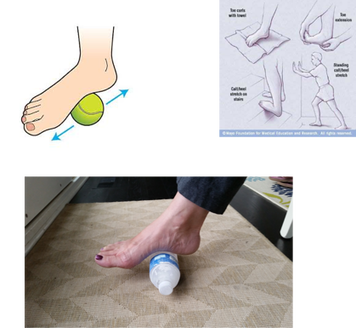|
8/17/2016 0 Comments Plantar Fasciitis Over 30 million people in America have been impacted by plantar fasciitis at some point during their lifetime. The condition can be found in persons of all ages but is most common among people between the ages of 40 and 60. Plantar fasciitis is a condition in which pain is found in the heel and can radiate down the arch and into the ball of the foot. The plantar fascia ligament is a band of fibrous tissue that connects the heel of the foot to the toes. Commonly, pain and discomfort from plantar fasciitis is worse after sitting for long periods of time and during those first few steps after getting out of bed in the morning. Plantar fasciitis pain results from flexion of the ligament past its normal range of motion and feels like you're over-stretching your foot simply by stepping on it. It can also be felt as pain under the heel of the foot, as if you have a lump in your socks or rocks in your shoes, which at first is merely irritating but can grow to be debilitating if left untreated. Over time the plantar fascia can wear out from everyday wear and tear causing it to become inflamed and painful. Other factors that increase your odds of suffering from plantar fasciitis include being overweight, spending long hours on your feet, walking barefoot in the sand for long distances, low or high arches, tight calf and ankle muscles, improper shoes, and running. Landing improperly on the heel while running can create a force of 7 times your body weight on the roughly two square inches that is your heel, which is obviously more than it was made to absorb. Although both men and women are affected by this condition women are twice as likely to suffer from plantar fasciitis due to their footwear. Women are more likely to wear flats, with little to no arch support, and high heels which are not only inflexible but also place the foot in a state of constant plantar flexion which shortens both the plantar fascia and the calf muscles, causing them to tighten. Therefore, if you are putting your feet through any of these common stressors, on a regular basis, you should be taking precautionary measures and if you already experience these symptoms the following conservative treatments will help alleviate, or even heal, pain as well. Stretches to help prevent and relieve plantar fasciitis symptoms include toe extension techniques, rolling over a tennis ball or frozen water bottle, and the calf/heel stretch on stairs/against the wall. Furthermore, people suffering from plantar fasciitis can try custom-fit orthotics or sleeping aides such as the Strassburg sock which keeps tension on the foot, and plantar fascia, so that it can heal in that stretched position at night. Strengthening exercises, massage therapy, and chiropractic care can also be part of the regime. How can chiropractic care help with the pain in your foot? Once you have been evaluated, your chiropractor may use a combination of techniques including, but not limited to, myofascial release, soft tissue mobilization, and the Graston technique on both the calf and foot. Myofascial release therapy will help release the shortness and tightness in the muscles and tendons. Soft tissue mobilization aides in detoxification of the body, improves range of motion, breaks up scar tissue, and promotes good blood circulation, which in turn promotes healing. Finally, the Graston technique is a form of soft tissue mobilization that uses stainless steel instruments to treat the plantar fascia, as well as numerous other areas. Patients often feel some relief after the first visit but will need to continue seeing the chiropractor, for at least several more sessions, to ensure that the plantar fascia heals and to prevent the pain from returning or worsening. Sources: American Orthopedic Foot & Ankle Society: http://www.aofas.org/footcaremd/conditions/ailments-of-the-heel/pages/plantar-fasciitis.aspx Houston Methodist: http://www.houstonmethodist.org/orthopedics/where-does-it-hurt/foot/plantar-fasciitis/ WomenTalk: http://community.healthywomen.org/profiles/blogs/plantar-fasciitis-one-big-pain-in-the-foot Medscape: http://emedicine.medscape.com/article/86143-overview#a6 Katie LaBarge St. Lawrence University '16 Chiropractic Assistant
0 Comments
|
AuthorMalorie Gardner, D.C. Archives
October 2016
Categories |
Website by North Shore Solutions
 RSS Feed
RSS Feed